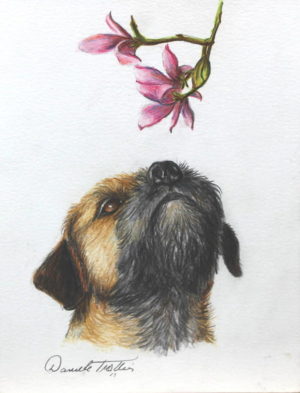
The Reedwater Terrier.
We think it’s one of dogdom’s best kept secrets, even though a random check of dog shows within a month revealed that they are the third most numerous terrier being shown in the conformation ring. One of the oldest and smallest of the British working terrier breeds, they are also one of the most unassuming: Excessive trimming or stylized grooming won’t be found here. In fact, the breed standard states that this breed is to be exhibited in its natural state, and at most, a tidying up of the dog’s head, neck and feet is required.
Ok, we’re misleading you just a tad, but it’s only because NPDD’s readers are such savvy dog people that we feel it’s “ok” to challenge you on occasion, so we’ll continue on for just a few sentences more
One would be hard pressed to find the Reedwater Terrier mentioned in dog books written after the turn of the century because it was an early name for the Ullswater Terrier, and that was another name for the Coquetdale Terrier. These three names were given to the little terriers found in the valleys in the border between Northumberland and Scotland where they were developed, farm dogs that lived out their lives as dreaded enemies of vermin. If you own a Border Terrier, you probably already know this because this is your breed’s history, and as an owner of one of these terrific little dogs, you are a steward of its breed.
By the late 19th century, these dogs came to be known as Border Terriers, probably because of their long association with the Border Hunt in Northumberland, and in particular, their “partnership” with Border Foxhounds. Border Terriers were the earth dogs that went to ground to bolt the hill foxes, and as such, they had to be strong and sturdy. That said, they needed to be able to follow a horse, and that took endurance and alacrity. Breed clubs have remained mindful of their breed’s original purpose by stipulating in their standards wording that recognizes breed’s original purpose. The AKC standard, for example, states that “since the Border Terrier is a working terrier…his conformation should be such that he be ideally built to do his job.” Boom. Enough said.
As for the grooming to which we alluded earlier, the breed’s scruffy face and beard suggest a “wash and go” breed, and by and large, the Border Terrier is. However, to preserve the water resistant nature of this breed’s coat, owners who show their dogs, participant in earth dog trials, or want their dogs to maintain its traditional coat texture will strip
out old coat when it has become overgrown and dead. Details about this process can be found here.
Image: “Spring” by Daniele Trottier is available for purchase here

Interesting to read about the ancestor breeds.
We agree, Oliver! Knowing what came before, its history and how it worked gives us so much insight into the breeds we love today! Thanks for commenting!
I just love this breed. I have two borderterriers. And I’m from Finland…
They are the best dogs ever! I wouldn’t be without my two!
Although they come from the border country (where my father was born!) of North Northumberland/Southern Scotland, as there is no actual “between” Northumberland and Scotland!
John, your “crew” is marvelous! Good to know that there isn’t actually a “between” between Northumberland and Scotland, thanks for writing and sharing a wonderful picture!
I love this breed. I wanted one for 10years but due to work commitments I couldn’t. Until 2 years ago when this lady came into my life. Unlike any other breed I have met.
If you have the time, Holly, in what was is the Border unlike other breeds?
I have one, they are independent, defiant little buggers! He drives me to tears when he has chased something, and doesnt come back (thank god for facebook!) but I wouldn’t be without him
It’s maddening, isn’t it, Marie? The little creatures that bring us so much joy also give us gray hairs.